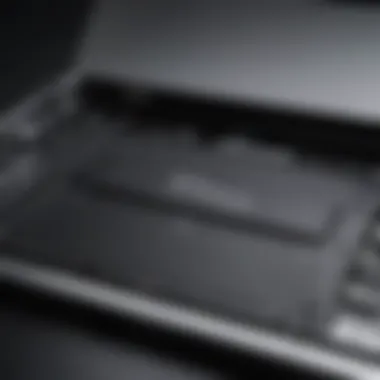Replacing Your MacBook Pro Battery: A Comprehensive Guide


Intro
In today’s fast-paced digital age, our devices are not just tools; they’re an extension of our daily lives. The MacBook Pro, which has earned a firm spot in the hearts of tech enthusiasts and everyday users alike, stands out for its sleek design and powerful performance. However, like any other electronic device, it is not without its quirks and challenges. One of the most pressing issues MacBook Pro users face is the longevity and eventual replacement of its battery.
Understanding whether you can replace your MacBook Pro battery can be a bit of a maze. Depending on the model, the procedure can range from straightforward to somewhat complicated. Not all batteries are created equal, and many factors come into play regarding whether it's a DIY job or one better left to the professionals. This article aims to dissect the labyrinth of battery replacement, taking into account various considerations from technical specs to practicality.
By examining the relevance of battery health in maintaining the MacBook Pro’s performance, and whether authorized service providers make more sense than tackling the task on your own, we aim to equip you with all the pertinent knowledge to make an informed decision.
So, let’s dig into the depths of the MacBook Pro battery situation—what can be replaced, how, and what you should know before getting your hands dirty.
Understanding MacBook Pro Batteries
Batteries are at the core of any laptop's functionality, and the MacBook Pro is no exception. Understanding the ins and outs of MacBook Pro batteries is crucial for both long-time users and newcomers alike. Knowing how they operate, their specifications, and their lifecycle can help you maintain optimal performance and possibly extend the lifespan of your device. When thinking about battery replacement, grasping these concepts can guide your choices, allowing you to discern between DIY replacements and professional services.
Types of Batteries Used
Lithium-ion Batteries
Lithium-ion batteries are the lifeblood of modern electronics, including the MacBook Pro. One of their most notable traits is their high energy density, which translates to more power packed into a lighter and smaller package. This is particularly advantageous for users who require portability without sacrificing performance.
Another aspect worth mentioning is their relatively low self-discharge rate. Unlike older nickel-cadmium batteries that could lose charge rapidly when not in use, lithium-ion batteries retain their juice much better. This means you can leave your MacBook Pro idle for longer periods without worrying about it losing power unnecessarily. An example of their capability can be seen in the MacBook Pro models, allowing for more than 10 hours of usage on a single charge under normal conditions.
However, there's a downside. Lithium-ion batteries can degrade over time due to various stress factors, which makes understanding their lifecycle essential for any user.
Battery Specifications by Model
Examining the battery specifications across different MacBook Pro models is key if you are considering a replacement. Each generation of the MacBook Pro comes equipped with batteries that are tailored to its respective hardware and usage needs. For instance, the 13-inch MacBook Pro might feature a battery with a lower capacity compared to the 16-inch model, but both are designed to optimise the performance of their respective machines.
This variation isn’t arbitrary. By tailoring battery specs, Apple ensures that each model operates efficiently. The specifications can include voltage ratings and capacity, which directly affects how long you can use the device before needing a charge. A benefit of understanding these details is that you can confidently choose the right replacement battery that won’t just fit but will also meet your performance expectations.
Battery Lifecycle and Performance
Understanding Battery Cycles
A critical concept in battery maintenance is understanding battery cycles. Each time you charge your MacBook Pro from 0% to 100% counts as a full cycle. However, this doesn't mean that the battery will reach the end of its life after a specific number of cycles; rather, it indicates the duration of performance reliability you can expect.
Generally, lithium-ion batteries are designed to last around 300 to 1000 cycles, depending on various factors, including usage patterns and ambient conditions. This knowledge lets users make informed decisions on battery care. For instance, deep discharging your battery frequently can hasten wear and tear.
Factors Affecting Battery Life
Various factors come into play when considering the life of your battery. One of the most significant is temperature; keeping your MacBook Pro in extreme heat or cold can adversely affect battery performance. Similarly, resource-heavy applications can lead to faster battery drain. Using applications that are not optimized may also demand more power than necessary, putting further stress on your battery.
In summary, understanding how your battery functions and what affects its life can help you adopt better practices for maintaining and possibly extending its longevity.
Identifying Battery Issues
Battery life affects both everyday usability and overall experience with your MacBook Pro. Hence, early detection of battery issues is strategic. Understanding how to identify these problems can save time, money, and frustration. By recognizing the signs of battery failure, users can take necessary steps to maintain their device’s health or decide if a replacement is worthwhile.
Signs of Battery Failure
Rapid Drain


Rapid battery drain is one of the most notorious indicators of battery issues. It’s like that friend who runs out of steam before a night out; one minute they’re full of energy, the next they want to head home. This behavior can stem from obsolescence, software problems, or more complex hardware glitches. When a MacBook Pro battery drains quickly, users will notice that it may drop from full to almost empty in just a few hours. One key characteristic is that apps running continuously often exacerbate this condition. Ignoring rapid drain could mean a trip to the repair shop becomes more imminent than anticipated. The unique feature of this issue is its ability to manifest without warning; you might power up your laptop for an average task, only to find it depleted in mere minutes. However, addressing this problem can mean updating software or managing power with care, which could extend battery life temporarily.
Overheating
Overheating is another red flag. Much like a boiling kettle, when a battery temperature rises excessively, it can lead to performance issues—or worse—potential damage. Users might notice their MacBook gets hot while charging or during resource-heavy tasks. This characteristic makes overheating a crucial topic for this article, as it points to deeper issues. Often, overheating results from intensive applications or underlying faults in the battery. The unique aspect of this condition is its dual impact; it not only affects battery longevity but can also lead to system instability. The downside is that users might ignore slight warmth, only to find themselves in a precarious situation later on.
Physical Damage
Physical damage might seem obvious, but it often goes unnoticed, especially if the signs are subtle. For instance, dents, swelling, or cracks in the battery's casing can hint at deeper issues lying beneath. What makes physical damage notable is how easily it can happen—drops, spills, or even prolonged exposure to heat can all contribute to this kind of degradation. Users should inspect their devices regularly; a small crack can progressively worsen, resulting in a significant hazard. Because of its visibility, addressing physical damage can expedite the decision to replace batteries or seek professional help, effectively preventing further complications.
Diagnostic Tools
Built-in Diagnostic Features
Apple provides several built-in diagnostic features to help users understand battery health. This characteristic is invaluable for those looking to self-assess before seeking external help. For example, running system diagnostics can yield information about battery cycles, charge levels, and overall condition. Users can quickly identify if their battery requires replacement based on some of these metrics. The unique aspect of using built-in diagnostics is that they usually don’t require third-party tools, making them easily accessible. However, the downside is that they may not provide a complete picture of total battery failure, leaving users wanting more clarification.
Third-Party Applications
Third-party applications can also play a crucial role in diagnosing battery health, offering deeper insights than the built-in options. Apps such as CoconutBattery or Battery Health 2 allow users to track more detailed metrics, including battery wear levels and cycle counts. This characteristic resonates with tech enthusiasts, as these applications can empower users with knowledge about their devices. The major advantage lies in their ability to present data in user-friendly formats, aiding in a comprehensive understanding of the battery’s status. However, reliance on third-party tools may introduce inconsistencies; not all apps are created equal, some might lack precision or reliability.
In the world of tech, being proactive often spells the difference between a smooth operation and a device that falters unexpectedly.
Replacement Options
When it comes to changing a MacBook Pro battery, knowing your replacement options can save you time, money, and headaches. You might find yourself pondering whether to take the DIY route or enlist professional help. Understanding the benefits and potential drawbacks of each option is crucial before you proceed.
DIY Battery Replacement
Tools Required
Opting for a DIY battery replacement can be a savvy choice if you prefer a hands-on approach and want to save some cash. To kick this off, you'll need the right tools. Essential items bracket a precision screwdriver set, a plastic spudger, and a suction cup, among others. These tools play a significant role puisqu'ils help prevent damage to delicate components. With proper tools, you can ensure a smoother replacement process.
The standout feature of these tools is that they offer a cost-effective solution which can be a game-changer for techies and hands-on individuals. However, if you're not very handy or comfortable with opening up electronics, it could lead to frustration.
Step-by-Step Guide
A well-laid-out step-by-step guide can be your lifesaver if you decide to venture into DIY territory. Such a guide typically provides detailed instructions on how to safely remove your old battery and install a new one. The beauty of this guide is that it breaks down complex procedures into manageable steps, ensuring you don’t feel overwhelmed. It often includes pictures and tips that show you're not completely in uncharted waters.
The unique feature of this guide lies in its structured format, allowing anyone to follow along with ease. On the downside, should things not go as planned, it can lead to more challenges and perhaps a less than satisfactory end product. So, thoroughness is your best friend here.
Professional Service Providers
As appealing as it may be to take matters into your own hands, there's a lot to be said for using professional services. Overall, this option could provide peace of mind if you lack the skills or tools necessary for a DIY task.
Apple Authorized Service Providers
When looking at professional options, Apple Authorized Service Providers stand out. These providers are recognized by Apple, meaning they have access to genuine parts and can carry out repairs under Apple's stringent standards. Choosing this option tends to be a safer bet since they offer warranties on their work and quality assurance.
Their main advantage is the reliability they bring to the table. Trying to save a buck by going elsewhere might seem tempting, but it doesn't always pan out. With an authorized provider, you essentially reduce risks associated with battery performance and compatibility. The trade-off, however, tends to be higher costs compared to a DIY project.
Third-Party Repair Services


If you find an Apple Authorized Service Provider feels a bit steep for your budget, then third-party repair services can serve as an enticing alternative. Many of these service centers offer competitive pricing and can get the job done quickly. They often provide flexible options that are hard to beat but remember that their credentials may vary widely.
The biggest upside is affordability, but that comes with its own set of potential downsides. Not all third-party services use genuine Apple parts, which can lead to issues with performance down the line. It's essential to do your homework and check reviews. Balancing price versus quality will be the name of the game here.
Always weigh your options carefully, especially when working on an expensive piece of tech. The goal here is to keep your MacBook Pro running well for as long as possible.
Considerations When Replacing a Battery
When contemplating a battery replacement for your MacBook Pro, a few key considerations come into play. Understanding these factors is crucial not only for maintaining device longevity but also for ensuring compliance with Apple's warranty regulations and maintaining performance standards. Simply put, approaching a battery replacement without due diligence could lead to complications you might not be prepared for.
First and foremost, warranty implications are a significant aspect to think about. Whether you are opting for a DIY approach or considering a professional service, you should reflect on how this might affect your warranty.
Additionally, battery compatibility is another area of concern. Matching your replacement battery not only to your specific MacBook model but also to the required specifications ensures that the new battery will function effectively. Confusion in this realm might lead to a range of issues, from underperformance to potential damage.
Therefore, this section aims to delve deeper into the considerations necessary for a successful MacBook Pro battery replacement, aiming at equipping you with comprehensive knowledge to make an informed decision.
Warranty Implications
Effect of DIY Replacement
Taking the DIY route for battery replacement comes with its own basket of pros and cons. A notable characteristic of this approach is the potential impact on your warranty. Many MacBook users may not realize that replacing the battery themselves could void their Apple warranty. This happens because Apple typically prefers that repairs be carried out by authorized personnel, ensuring the use of authentic parts and standard practices. While DIY is typically seen as a cost-effective and empowering option, it can backfire if not managed properly.
From a technological standpoint, a DIY replacement means relying on your tools and knowledge base, which might be limited. If something goes wrong post-replacement, you may find yourself in a tight spot without warranty coverage. Ultimately, while taking the DIY route can also be empowering, it's key to weigh the trade-offs and assess your own capabilities and the potential ramifications.
Service Provider Credentials
Opting for a professional service comes with its own considerations, primarily centered on service provider credentials. Choosing a certified technician or an authorized service provider can bring peace of mind, especially since they have the right tools and know-how for the job. A predominant advantage of these providers is their affiliation with Apple, reassuring you that you're receiving service aligned with Apple standards.
Moreover, these credentials ensure that the parts used are original and adhere to the specific needs of your MacBook Pro model. Nonetheless, this choice tends to be more expensive than going the DIY route, requiring careful budgeting and sometimes unexpected delays due to high demand.
Battery Compatibility
Matching Specifications
In the realm of battery replacement, matching specifications is a non-negotiable part of the process. This aspect focuses on ensuring that the battery you purchase aligns with the specifications set forth by Apple for your specific model. Each MacBook Pro series might feature different battery sizes, voltage requirements, and fittings.
Not only does this serve to maintain the performance of your device, but it also guards against safety risks. An ill-fitting or incompatible battery can lead to malfunction. So, when exploring options for battery replacements, be meticulous in verifying that the new battery has the correct specifications. Neglecting this can render your replacement futile, and you’ll find yourself back at square one.
Aftermarket vs. OEM Batteries
This brings us to the choice between aftermarket and OEM (Original Equipment Manufacturer) batteries. OEM batteries are manufactured by Apple’s suppliers and come with a guarantee of compatibility and performance. In contrast, aftermarket batteries might tempt you with lower prices, but they can often be a mixed bag; some perform well while others don’t live up to standards.
A distinct feature of aftermarket options is their variety—there can be different brands that offer these batteries, each coming with various pros and cons regarding price and performance. The potential advantage of aftermarket batteries lies in their affordability, but it’s important to remain cautious; not all aftermarket products are created equal. Poor quality can lead to issues like rapid drainage or overheating. Ultimately, choosing the right type of battery comes down to balancing cost with reliability and ensuring you are comfortable with your decision.
In summary, carefully considering warranty implications, service provider credentials, battery compatibility, and the choice between OEM and aftermarket batteries can make all the difference for your MacBook Pro. By being well-informed, you'll set yourself on the right path to a successful battery replacement.
Maintaining MacBook Pro Battery Health
When it comes to getting the most out of your MacBook Pro, paying attention to the battery health is crucial. It’s not just about keeping the laptop in top shape; it’s about extending its usability and ensuring that it performs as expected over time. Maintaining battery health can ultimately lead to a better experience and can spare users from unnecessary hassle.
There are a couple of key elements to focus on:


- Best Practices for Battery Care
- Using Software Tools
Best Practices for Battery Care
Optimizing Charging Habits
Optimizing charging habits is one of the most significant aspects of prolonging your battery life. A common mistake users make is charging their MacBook Pro to 100% every time. However, keeping the charge between 20% and 80% can prevent stress on the battery. This practice ensures that the lithium-ion battery doesn’t go through extreme charge cycles, which can lead to quicker degradation.
Moreover, frequent discharging to extremely low levels should be avoided. This balancing act is a beneficial strategy that maintains battery performance for the long run. One unique aspect here is the focus on not letting the battery drop below a certain threshold frequently. This discipline can noticeably enhance the lifespan of the battery.
Temperature Management
Temperature management is equally crucial in maintaining MacBook Pro battery health. High temperatures can cause batteries to swell or even leak, while extremely low temperatures might hinder their performance temporarily. Keeping your device in a cool, dry place is often recommended.
Moreover, monitoring the operating temperature during use is beneficial. Overheating can be a silent killer; casual users often do not recognize it until it’s too late. The unique feature of managing temperature is simple: just be mindful of your environment. While it may seem trivial, neglecting this can lead to drastic effects on performance and battery health.
Using Software Tools
Monitoring Battery Health
Monitoring battery health is another key aspect of maintaining your MacBook Pro’s battery. Using built-in tools and third-party applications allows users to get a clear view of battery status, cycle count, and even overall performance. Many people don't realize how valuable this information can be.
A good characteristic of battery monitoring is its role in prevention. Knowing when a battery might be on the decline can save users from unexpected shut-downs or other failures. What makes this unique is that users can see real-time data rather than waiting for signs of failure. For instance, if a user notices a concerning drop in health, they can take action early rather than later when replacement might be their only option.
Calibrating the Battery
Calibrating the battery, while often overlooked, serves a critical function in maintaining battery health. By following specific calibration steps—discharging the battery completely and then fully charging it—you help the operating system learn the true maximum and minimum capacity of your battery. This goes a long way in accuracy of battery readings.
One of the advantages is that it can improve battery performance. However, this method is not fool-proof. If done too frequently, it can actually hasten battery wear. Ideally, calibration should happen only once every few months or when you notice discrepancies in battery status reports. Knowing when and how to calibrate can mean the difference between optimal performance and an irritation.
"Taking proactive steps to maintain battery health often prevents bigger issues down the line, ensuring that your MacBook Pro remains reliable over years of use."
Actively maintaining your MacBook Pro battery health plays an invaluable role in its longevity and performance. By sticking to these practices and using the right tools, you can navigate the ups and downs of technology with ease and avoid unnecessary replacements.
Frequently Asked Questions
In every field, questions arise that pique curiosity and clarity. The Frequently Asked Questions section serves as a lighthouse for those navigating the often murky waters of battery replacement for MacBook Pro. Here, we provide essential insights that directly address common worries and interests that users harbor. Not only do these questions reflect real user experiences, but they also distill years of information into accessible nuggets for readers. Understanding these key points can drastically influence decision-making when it comes to standard practices for battery care and replacement.
How Long Does a MacBook Pro Battery Last?
The lifespan of a MacBook Pro battery can vary widely depending on usage habits and settings. Generally, Apple suggests that the battery should retain up to 80% capacity after around 1000 charge cycles. This translates to roughly three to five years of typical use; however, this can diminish with heavy workload or improper care. Regularly performing tasks like checking battery health through macOS can tip you off when it’s time for a replacement.
"A penny for your thoughts? A new battery might cost a bit more than that, but it surely pays off in performance!"
Can Replace My Battery Without Losing Data?
Rest assured, replacing a MacBook Pro battery should not inherently jeopardize your data. The battery is separate from the internal storage system, so as long as you follow proper disassembly procedures, your files remain intact. That being said, it is always wise to back up your data before attempting any hardware changes, even if just to avoid unexpected outcomes that can arise from technical errors or mishaps during the replacement process. Tools like Time Machine can make this backup process seamless and effective.
What to Do If My MacBook Doesn’t Turn On After a Battery Replacement?
If your MacBook Pro refuses to spring to life post-replacement, don't wave the white flag just yet. There are several troubleshooting steps to consider:
- Ensure Proper Connections: Open up the MacBook again and check if all battery connectors are securely in place.
- Reset the SMC: The System Management Controller can be reset, which may rectify issues by restoring elements like power management. This can be done by pressing shift+control+option on the left side of the built-in keyboard and the power button, holding for ten seconds.
- Check the Battery: Sometimes, the replacement battery may be defective; trying with another one can help.
Keep a keen eye on details, as sometimes it’s the smallest things that cause the biggest headaches.
By addressing these FAQs directly, we not only emphasize important details about battery life, data safety, and troubleshooting, but we also empower users with the knowledge to make informed decisions. Those engaged in the world of MacBook Pro devices will find that understanding these components is critical for maintaining the long-term health and performance of their machines.



